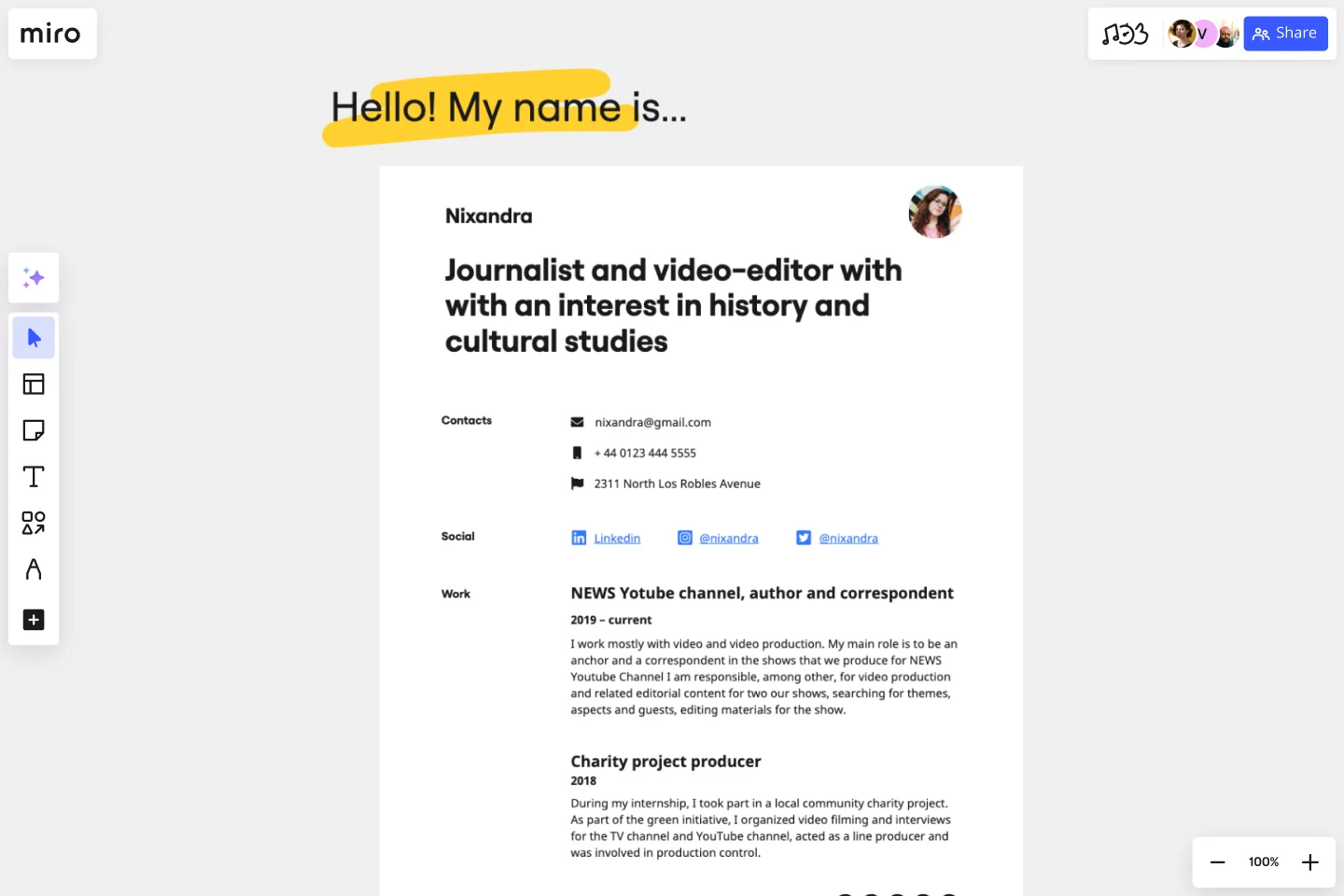Portfolio Template
Showcase your work with Miro’s Portfolio Template and achieve success in every interview.
About the Portfolio template
The portfolio template is a way for you to showcase your best work visually. It has an in-depth description of your skills, abilities, and potential for the future. Unlike a resume, where you only summarize information about your previous positions and education, a portfolio brings together more detailed information about your career path and journey, and it can contain your creative expression.
What is a Portfolio template?
The portfolio template is a set of pages or web pages showing your career’s narrative, achievements, expertise, and future goals.
Depending on what industry you are in, your portfolio template might look different. Most creative professionals highlight their self-expression and innovative work in their portfolios, whereas more traditional sectors will demand from professionals another approach to their portfolio.
Regardless of your industry, some fields must be present in your portfolio:
Your contact information
Your last position and previous ones in a chronological order
Skills
Projects
Education
Languages (when applicable)
When to use a Portfolio template
Most professionals and job seekers use portfolios to present themselves creatively and show prospective employers what they have achieved in their professional lives and what they can bring to their organization.
You can use a portfolio template when applying for job positions, universities, or training programs. You can also use it as your online visit card, an excellent way to market yourself to future employers and business partners.
How to create a Portfolio template
Miro’s virtual collaboration platform can help you design your portfolio the way you want it. You can start building your online portfolio following these steps:
Add the basic information about yourself, with your contact details and links.
List your professional experience in descending order, and make sure to highlight your primary responsibilities and projects for each.
Add your skills and briefly include your level of expertise.
What work samples do you want to add? Select the best work to showcase. If you are a journalist, think of the best pieces you have written, designers can add the best campaigns they’ve designed or other design projects, teachers can add their best lesson plans or educational projects.
At last, add your educational journey and languages (if applicable).
How do you create a portfolio template?
You can create your portfolio with Miro’s whiteboard tool, simply following the steps described above. Or, you can also use the portfolio template from our library and edit it to your needs. To get some inspiration, you can also check with your peers and research your industry to see how they design portfolios. It’s important to remember that your portfolio should reflect your career path and your professional profile.
How do you write a portfolio?
Write your portfolio concisely and clearly. Think about who will read your portfolio and what sort of impression you want them to have about you and your work. Creative professionals can sometimes use a more informal tone of voice. In contrast, people working in more traditional industries such as finance or engineering might have to opt for a more neutral, clear formal way of writing.
Get started with this template right now.
Google Cloud Architecture Diagram Template
Works best for:
Software Development, Diagrams
Use the Google Cloud Architecture Diagram template to clearly visualize the deployment of your application and allow you and your team to optimize processes. The GCP template gives you a great overview of your application architecture, and it helps you to iterate quickly and better manage your application development, deployment, and documentation. Try it out and see if it works for you.
Customer Journey Mapping Template Pack
Works best for:
Mapping, User Experience, Workshops
A customer journey map (CJM) is a visual representation of your customer’s experience. It allows you to capture the path that a customer follows when they buy a product, sign up for a service, or otherwise interact with your site. Most maps include a specific persona, outlines their customer experience from beginning to end, and captures the potential emotional highs and lows of interacting with the product or service. Use this template to easily create customer journey maps for projects of all kinds.
Agile Board Template
Works best for:
Agile Methodology, Meetings, Agile Workflows
Part of the popular Agile framework, an Agile Board is a visual display that allows you to sync on tasks throughout a production cycle. The Agile Board is typically used in the context of Agile development methods like Kanban and Scrum, but anyone can adopt the tool. Used by software developers and project managers, the Agile Board helps manage workload in a flexible, transparent and iterative way. The Agile template provides an easy way to get started with a premade layout of sticky notes customizable for your tasks and team.
UML Activity Diagram Template
Works best for:
Diagrams
Use our Activity Diagram template to break down activities into smaller decisions and subprocesses. Improve and optimize systems and processes in I.T., business management, and more.
Brand Strategy Template
Works best for:
Marketing
Develop a brand strategy for new and existing brands with this fully guided Brand Strategy Template. Find new ways to build your brand and set your business up for success.
Euler Diagram Template
Works best for:
Business Management, Operations, Diagrams
Euler diagrams are valuable for showing different relationships between subjects by representing them with circles or "cells." Euler diagrams are frequently used in IT systems to show how objects relate to one another and how they interact. However, you can use them for any sort of explanation that needs to show connections.
